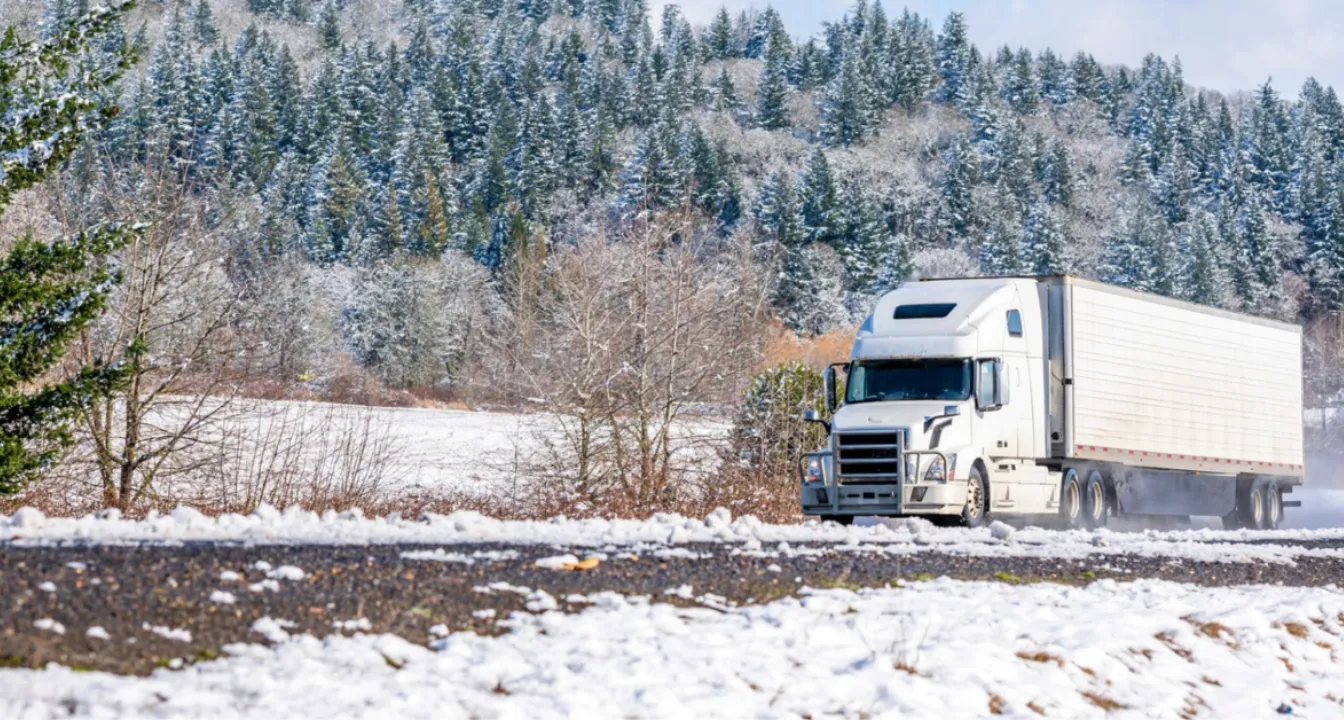Cold weather brings serious risks for truckers, as diesel fuel can gel when temperatures drop. Once fuel thickens, it clogs filters and prevents fuel from flowing properly. Winter blend diesel fuel is specifically formulated diesel that mixes No. 1 and No. 2 diesel to prevent gelling in freezing temperatures. At OTR Solutions, we help carriers manage seasonal fuel costs through strategic tools and reliable support. In this article, we'll cover what winter blend diesel is, when it's used, how it affects your costs, and practical ways to save money this winter with the OTR Fuel Card and smart fuel management strategies. As truckers prepare for the holiday trucking rush, winter fuel blends become a critical consideration for maintaining operations and protecting your bottom line.
Key Takeaways:
- Winter blend prevents costly breakdowns – by lowering the gel point of diesel fuel, keeping your truck running smoothly in temperatures that would freeze standard summer diesel.
- Fuel costs rise during winter months – due to the more expensive refining process for winter blends, making fuel card discounts and strategic planning essential for maintaining profitability.
- Timing varies by region and temperature – with northern states switching to winter blends as early as October, while southern regions may wait until December or skip winter blends entirely.
- Fuel efficiency decreases slightly with winter blends – since No. 1 diesel contains less energy per gallon than No. 2 diesel. This means you may notice a modest dip in miles per gallon during cold weather.
What is Winter Blend Diesel Fuel?
Winter blend diesel fuel is a carefully formulated mixture of No. 1 and No. 2 diesel designed to prevent fuel from gelling in cold temperatures. Winter blends are designed to lower the cloud point and cold filter plugging point of diesel, which helps keep fuel flowing freely through your system even in freezing weather.
How Winter Blend Chemistry Works
The chemical changes in winter blend diesel primarily involve reducing paraffin content.
- Paraffin wax problems: Naturally exists in diesel fuel but solidifies in cold weather, creating gel-like substances that clog fuel filters
- No. 1 diesel composition: Contains fewer long-chain hydrocarbons and paraffins than No. 2 diesel
- Gelling resistance tradeoff: Lower paraffin content makes fuel more resistant to gelling but less energy-dense
- Regional customization: Refineries adjust the ratio of No. 1 to No. 2 diesel based on expected temperatures in different regions
Regional Blend Variations
Regional refineries produce different winter blend ratios based on local climate conditions. Northern states receive stronger winter blends with higher percentages of No. 1 diesel. Southern states may use milder blends or continue using summer diesel with additives. Understanding seasonal trucking fuel costs helps you budget effectively for these regional price variations.
Regional refineries produce different winter blend ratios based on local climate conditions. Northern states receive stronger winter blends with higher percentages of No. 1 diesel. Southern states may use milder blends or continue using summer diesel with additives. Refineries in colder regions adjust their fuel with higher amounts of No. 1 diesel during extreme cold, helping reduce filter plugging and fuel gelling problems.
What Type of Diesel Fuel Is Winter Blend?
Winter blend diesel combines two distinct fuel types to create a cold-weather solution. No. 1 diesel, also called kerosene or light diesel, offers excellent cold-flow properties but delivers less energy per gallon. No. 2 diesel, the standard diesel fuel used in warmer months, provides more power and better fuel economy. However, it gels quickly in freezing temperatures. The winter blend isn't a separate type of diesel. It's a strategic mixture that balances cold-weather performance with energy content. Here's how the two components compare:
You'll still notice some changes in fuel economy compared to summer operations. Fuel costs rise when switching to winter blends, making discounts from a fuel card even more valuable. Just as understanding diesel fuel weight matters for load calculations, knowing your fuel blend helps you plan for performance variations.
When Does Winter Blend Diesel Fuel Come Out?
Winter blend diesel typically appears at truck stops from October through March. Exact timing varies significantly by region and climate. Northern states like Minnesota, North Dakota, and Montana switch to winter blends as early as October. Southern states may not transition until December or may skip winter blends entirely in favor of fuel additives.
Regional Switchover Timeline
The switchover isn't governed by a specific calendar date. Instead, it depends on regional temperature forecasts and historical weather patterns. Fuel suppliers monitor weather predictions and begin blending winter diesel when sustained temperatures below 20 degrees Fahrenheit become likely. Truck stops in different states make the transition at different times:
- Upper Midwest and Northern Plains: Early to mid-October
- Northeast and Mountain West: Mid to late October
- Mid-Atlantic and Lower Midwest: Late October to early November
- Southern states: Late November to December, if at all
- Gulf Coast and Southwest: Rarely switch or use minimal winter additives
Spring Transition Back to Summer Blend
The spring transition back to summer diesel occurs gradually as temperatures stabilize above freezing. Most regions complete the switch by late March or early April. Northern areas may continue selling winter blends into May. This extended timeline protects against late-season cold snaps that could still cause fuel gelling problems.
Diesel Fuel Winter Blending Chart
The recommended blend ratios for different temperature ranges help you anticipate what you're pumping at each stop. This chart shows the typical industry-standard ratios refineries use.
These ratios represent general guidelines. Actual blends at your local truck stop may vary based on the supplier's specific formulation and regional requirements. Some refineries use cold-flow improver additives to reduce the chance of gelling. These additives allow diesel to perform better in severe cold weather without relying solely on No. 1 diesel. Knowing the blend helps truckers budget fuel expenses. Using a fuel card can offset the higher cost of blends with discounts. Reefer fuel requirements become even more critical in winter, as reefer units need reliable fuel flow to maintain temperature control in cargo.
Winter Blend Diesel vs. Summer Blend
The key differences between winter and summer diesel blends affect your truck's performance, operating costs, and maintenance needs. These variations require adjustments to your operational strategies as seasons change.
When fuel costs rise in winter, carriers can smooth cashflow with OTR's fuel card line of credit. This helps you manage the increased fuel costs that come with winter operations without worrying about cashflow hiccups.
How to Save on Winter Blend Diesel
Managing winter fuel costs requires strategic planning and the right tools to offset the seasonal price increases and efficiency losses that come with cold-weather blends. Winter planning becomes easier with OTR's dedicated operations team available to help carriers navigate seasonal trucking fuel cost challenges.
Use Fuel Card Networks With Winter Discounts
Fuel card programs that offer per-gallon discounts become especially valuable during the winter months when base fuel prices rise. The OTR Fuel Card provides average savings of $0.50 per gallon at 2,500+ in-network locations, with discounts reaching up to $2.25 per gallon at select truck stops. These savings directly offset the premium you pay for winter blend diesel.
Network coverage matters more in winter when weather conditions may force route changes. Cards accepted at 8,000+ locations nationwide give you the flexibility to find discounted fuel. This helps even when your planned stops become inaccessible due to winter storms or road closures.
Plan Fuel Stops Strategically
Route planning takes on added importance during the winter months. Filling up before entering higher-cost regions saves money. This is especially true when crossing state lines, where fuel prices can vary by 40 cents per gallon or more. Learning how to find the cheapest diesel fuel becomes critical when winter blend prices add another layer of cost to your fuel budget.
The Fuel Finder feature built into the OTR Mobile App shows you real-time pricing at truck stops along your route. This makes it easier to identify the best fueling opportunities.
Consider these strategic planning tips:
- Tax-friendly states: Fill up in states with lower fuel taxes before entering high-tax states
- Major truck stops: Fuel up at major truck stops with competitive pricing rather than small stations
- Network discounts: Time your fuel stops to take advantage of network discounts at preferred locations
- Weather planning: Monitor weather forecasts to avoid getting caught with a low tank before winter storms
Monitor Your MPG Changes
Winter blend diesel's lower energy content means you'll see reduced fuel economy compared to summer operations. Tracking your miles per gallon helps you identify how much the seasonal change affects your specific truck and driving patterns. Most trucks experience a 2-5% decrease in fuel economy. Individual results vary based on engine type, load weight, and driving conditions.
Avoid Unnecessary Idling
Extended idling wastes fuel in winter when diesel engines work harder to maintain operating temperature. Some idling is necessary for cab heating and engine protection in extreme cold. However, excessive idling burns an extra 0.8 to 1.0 gallons per hour with no miles driven.
Modern auxiliary power units and bunk heaters provide more efficient alternatives:
- APU efficiency: Use a fraction of the fuel required for extended idling
- Bunk heater benefits: Maintain overnight comfort without running the main engine
- Limited warm-up time: Limit warm-up idling to 3-5 minutes before driving
- Load-based warming: Modern diesel engines warm up faster when driving with minimal throttle than when sitting idle
OTR's Fuel Card provides nationwide discounts, even on winter blend. The credit option helps carriers manage seasonal spikes without straining cashflow. These winter fuel management strategies work best when combined with reliable financing tools available when you pair the OTR Fuel Card with OTR Solutions' True Non-Recourse Factoring.
Keep Your Fleet Moving This Winter
Winter blend diesel serves as essential protection against costly breakdowns and delays that gelling fuel causes in freezing temperatures. You'll pay slightly more per gallon and see modest decreases in fuel economy. These trade-offs prevent far greater expenses of emergency repairs, towing, and missed delivery windows.
The OTR Fuel Card provides the tools you need to navigate seasonal fuel challenges. It combines nationwide network coverage with significant per-gallon savings and flexible credit options for factoring clients. Ready to strengthen your winter fuel strategy? Apply for the OTR Fuel Card to start saving an average of $0.50 per gallon at 2,500+ truck stops nationwide.
Frequently Asked Questions
What is winter blend diesel fuel?
Winter blend diesel fuel is a mix of No. 1 and No. 2 diesel designed to prevent fuel gelling in cold weather. It flows better at low temperatures but has slightly less energy per gallon than summer diesel.
When does winter blend diesel start being sold?
Most truck stops and refineries switch to winter blend diesel in the fall, typically around October. They continue offering it through early spring. The exact timing depends on the region's climate.
Is winter blend diesel more expensive?
Yes, winter blend is usually more expensive. It requires additional refining and contains No. 1 diesel, which costs more to produce.
Can you use summer diesel in the winter?
Using untreated summer diesel in freezing weather can cause the fuel to gel, depending on the temperature in your region. This clogs filters and prevents engines from starting. That's why winter blend or fuel additives are necessary in cold regions.
Does winter blend diesel affect fuel mileage?
Yes, winter blend contains less energy per gallon than summer diesel. Drivers may notice a slight decrease in miles per gallon (MPG).
How can truckers save money on winter blend diesel?
Truckers can save by planning fuel stops strategically and avoiding unnecessary idling. Using fuel card savings compared to credit cards also helps. Carriers can manage higher winter fuel costs with tools like the OTR Fuel Card and fuel credit options.
A smart move in the right direction.
New to the business or expanding your fleet, we only succeed when you do. We’ll bring the tools and support. You bring the hustle. Let’s move forward together.






